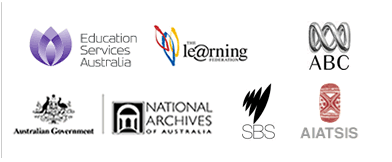Original classification rating: M.
This clip chosen to be PG
Clip description
On the trail of 'wild blacks’ who have speared cattle, the stockmen and Mrs Gunn (Angela Punch McGregor) discuss the question of prior right to the land. An elderly Aboriginal man, Goggle Eye (Donald Blitner) explains where the stars came from, and wonders why God never gave the white man land of his own.
Curator’s notes
This is an interesting scene for the way it contrasts two cosmologies, both based on powerful mythology. Goggle Eye seems to understand that his mythology is not theirs, but they don’t afford him the same courtesy. The stockmen are ignorant of the stars, and stumped by his question, but Mrs Gunn has an answer – God made everything – that she feels trumps his belief system. Never mind that his is thousands of years older and probably based on a thorough traditional knowledge of the solar system. The use of two campfires, besides giving a shockingly clear example of the tradition of apartheid that was common on cattle stations across Australia at the time, also gives a sense of the two cosmologies – two fires, like two suns.
Teacher’s notes
provided by 

This clip shows Jeannie Gunn (Angela Punch McGregor) and her husband Aeneas (Arthur Dignam) sitting under the stars with two stockmen (John Jarratt and Martin Vaughan) and an Aboriginal man they refer to as Goggle Eye (Donald Blintner), who sits at a distance from them as they engage in a discussion about the origin of the stars, ownership of the land, and the right of Aboriginal peoples to hunt on the land. When asked to explain the origin of the stars Goggle Eye tells his Dreaming of their creation and then asks about the origin of ‘white fella stars’. Jeannie says that God made all the stars, but later adds with more respect than shown by the non-Indigenous men that she wants to learn from Aboriginal people.
Educational value points
- The clip reveals the gulf between the cultural beliefs of the Gunns and the stockmen and those of Goggle Eye, the Aboriginal tracker, in the discussion of the creation of the world and in the differing ideas about the land. The gulf is represented physically through the separate camp fires and by the way Goggle Eye faces towards the bush and the night sky. It is then further illustrated when Jeannie Gunn rejects Goggle Eye’s Dreaming and insists on the Christian viewpoint that ‘God made everything’ as the only legitimate belief.
- Goggle Eye’s question – ‘if white fella god made everything, why didn’t he make white fellas some bush of their own?’ – reveals the profound differences of attitude and belief around the concept of land ownership between Europeans and Indigenous people. Aboriginal people’s connection to country is illustrated when Goggle Eye knows exactly where the people they are pursuing are headed; he says they are going to their country. This is in contrast with the Western concept of land ownership, in which individuals use the land primarily for economic benefit. One of the stockmen says that where they are heading is still within the boundary of Elsey station.
- Goggle Eye sits at his fire and looks outward as he tells his Dreaming story about the creation of the moon and stars. Stories such as this one explain how the world was created and why places have particular significance.
- Goggle Eye’s question to Jeannie about where the ‘white fella stars come from’ reveals certitude in his cosmology, but also suggests his preparedness to listen to another person’s viewpoint. His openness to the possibility of another belief system may also be suggested when he questions (albeit perhaps ironically) why the ‘white fella god’ did not make ‘white fella some bush of their own’.
- When one of the stockmen says that the country was ‘empty’ when he first came to it Jeannie challenges his view by rightfully pointing out that Aboriginal people were already there when he arrived. He acknowledges this, but dismisses any rights of Indigenous people to the land, saying he sees no visible signs of the Indigenous peoples working the land as he would.
- The language used by the stockmen in the clip illustrates the racist attitudes common at the beginning of the 20th century. The stockman refers to Goggle Eye and Indigenous Australians as ‘ignorant heathens’ because they are not Christians and dismisses them with the words ‘you can’t teach them anything’ without questioning why Indigenous people might not want to accept such ‘teaching’. The use of the name ‘Goggle Eye’ itself is offensive.
- Jeannie Gunn (1870-1961) wrote We of the Never Never as a fictionalised account of her time on Elsey Station in the Northern Territory. Born in Carlton, Melbourne, she worked as a teacher before she married Aeneas Gunn in 1901. The next year they travelled to Elsey Station, 483 km south of Darwin. When Aeneas died in 1903, Jeannie returned to Melbourne and wrote The Little Black Princess, published in 1905, and We of the Never Never, published in 1908.
Thanks to the generosity of the rights holders, we are able to offer 'Some bush of their own' from the feature film We of the Never Never as a high quality video download.
To play the downloadable video, you need QuickTime 7.0, VLC, or similar.
You must read and agree to the following terms and conditions before downloading the clip:
australianscreen is produced by the National Film and Sound Archive. By using the website you agree to comply with the terms and conditions described elsewhere on this site. The NFSA may amend the 'Conditions of Use’ from time to time without notice.
All materials on the site, including but not limited to text, video clips, audio clips, designs, logos, illustrations and still images, are protected by the Copyright Laws of Australia and international conventions.
When you access australianscreen you agree that:
- You may retrieve materials for information only.
- You may download materials for your personal use or for non-commercial educational purposes, but you must not publish them elsewhere or redistribute clips in any way.
- You may embed the clip for non-commercial educational purposes including for use on a school intranet site or a school resource catalogue.
- The National Film and Sound Archive’s permission must be sought to amend any information in the materials, unless otherwise stated in notices throughout the Site.
All other rights reserved.
ANY UNAUTHORISED USE OF MATERIAL ON THIS SITE MAY RESULT IN CIVIL AND CRIMINAL LIABILITY.
This clip is available in the following configurations:
| File name | Size | Quality | Suitability |
|
weofthen3_pr.mp4
|
Large: 19.4MB |
High |
Optimised for full-screen display on a fast computer. |
|
weofthen3_bb.mp4
|
Medium: 9.2MB |
Medium |
Can be displayed full screen. Also suitable for video iPods. |
Right-click on the links above to download video files to your computer.
Thanks to the generosity of the rights holders, we are able to offer this clip in an embeddable format for personal or non-commercial educational use in full form on your own website or your own blog.
You must read and agree to the following terms and conditions before embedding the clip:
australianscreen is produced by the National Film and Sound Archive. By using the website you agree to comply with the terms and conditions described elsewhere on this site. The NFSA may amend the 'Conditions of Use’ from time to time without notice.
All materials on the site, including but not limited to text, video clips, audio clips, designs, logos, illustrations and still images, are protected by the Copyright Laws of Australia and international conventions.
When you access australianscreen you agree that:
- You may retrieve materials for information only.
- You may download materials for your personal use or for non-commercial educational purposes, but you must not publish them elsewhere or redistribute clips in any way.
- You may embed the clip for non-commercial educational purposes including for use on a school intranet site or a school resource catalogue.
- The National Film and Sound Archive’s permission must be sought to amend any information in the materials, unless otherwise stated in notices throughout the Site.
All other rights reserved.
ANY UNAUTHORISED USE OF MATERIAL ON THIS SITE MAY RESULT IN CIVIL AND CRIMINAL LIABILITY.
Copy and paste the following code into your own web page to embed this clip:




 Share
Share





